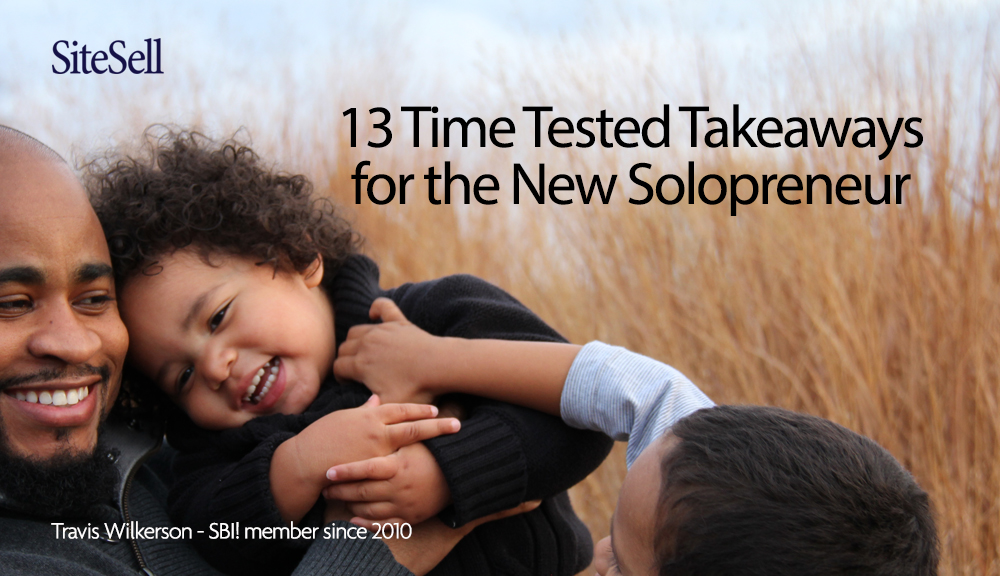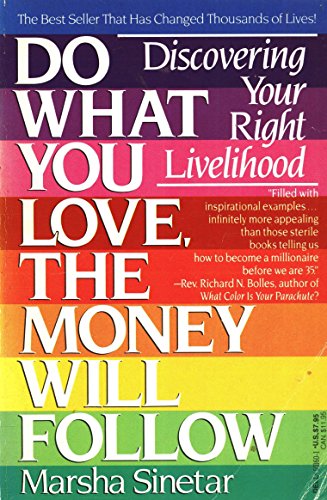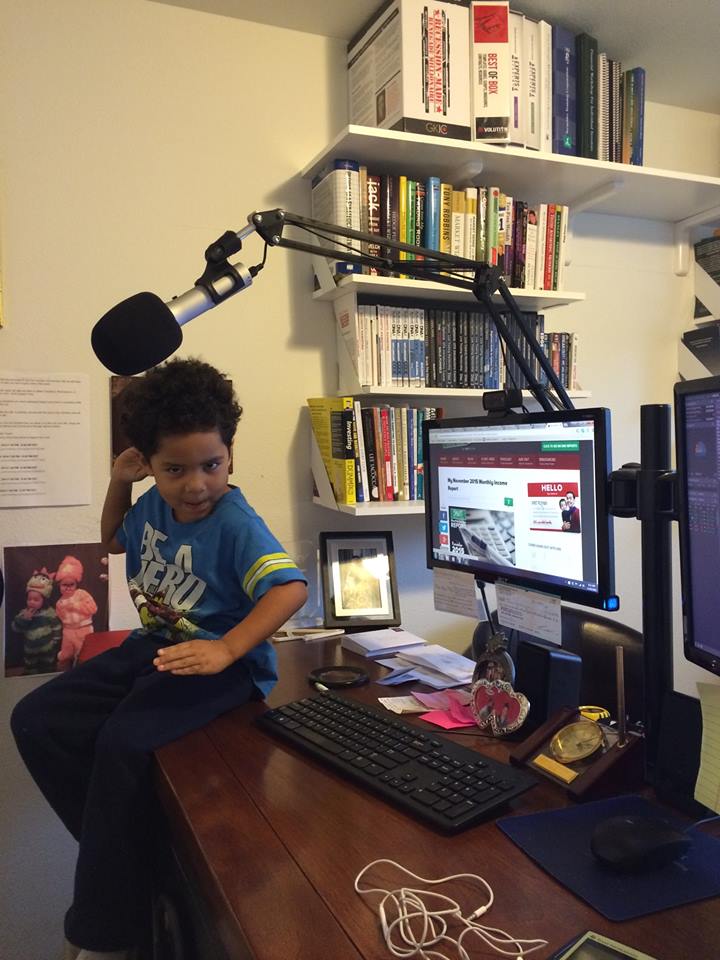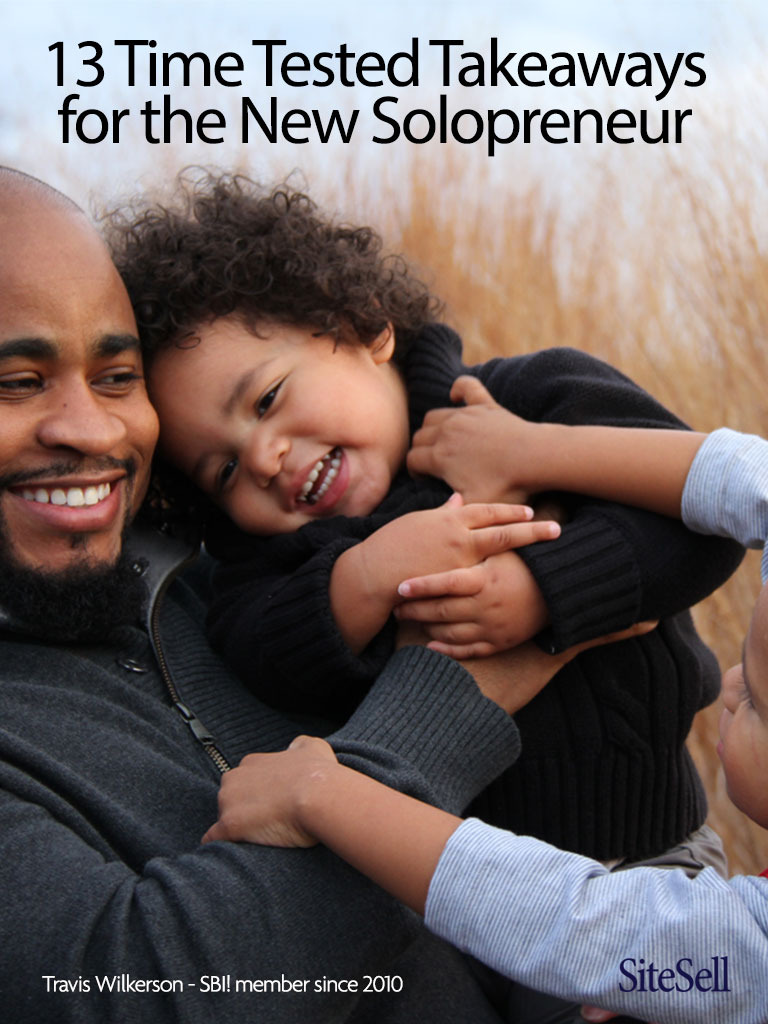
I measure success by how many lives I can change, not by how much money I make from selling.Travis Wilkerson from learn-stock-options-trading.com
 That’s classic Do What You Love, The Money will Follow, a book we recommend for those trying to find their way.
That’s classic Do What You Love, The Money will Follow, a book we recommend for those trying to find their way.
Travis Wilkerson grew up American poor, in a house without running water or a bathroom. He was taught that all rich people are evil and greedy.
In his early twenties he met his first mentor who showed him how to raise himself out of poverty through investing… without doing evil.
Travis was hooked. He was so excited, he talked about it all day… to his wife. She, unfortunately, did not share his love for investing. She did, though, make one suggestion that changed Travis’s life forever.
Now let’s hear the story from Travis himself…
1. Travis, I’ve heard you say that your site, www.learn-stock-options-trading.com, exists because of your wife. What’s the story behind that?
First, here’s the story behind that story!
I was born in a small town in the state of Virginia. Our house had no running water or bathroom. For baths, we pumped water from a well, heated it up on the stove, and then we all took a bath in a galvanized tin tub. Our household toilet was a 5-gallon paint bucket and our outside toilet was a wood shack over a hole in the ground (aka an “outhouse”).
In short, we “grew up American-poor.”

Like most poor kids, I was taught that all rich people were evil and greedy.
Fast forward a few years and I’m now in my twenties, serving in the United States Army. It was there that I met a guy who taught me what the word “investing” meant.
Once I understood how people could rise out of poverty (through investing), I became hooked. I read about it non-stop. I was so excited that I talked about this newfound information with anybody I could.
And here is where my wife enters the picture…
Like many enthusiastic, but clueless, husbands I was dominating most of the conversations in our home. The topic of discussion? Investing!
Investing is my passion, but if you are a wife who doesn’t share your husband’s passion it can be annoying to hear about it every single day.
Naturally, I wore her out. One day, she suggested I create a blog about investing. She figured that if I was writing about it non-stop, that she’d be spared!
At first I was a little offended. I couldn’t get how anyone couldn’t be as passionate about investing as I was. I finally did “hear” what she said, stopped being an emotional diva about it.
Later on I realized her advice was brilliant. Why inflict my passion on everyone I’d meet (and my patient wife) when others with the same passion could find me?
She showed me that I needed to create something for my target audience instead of trying to talk to, and appeal to, everyone. I also figured that I could use it when I created my first product. So I owe it all to my wife in one sense.
Only one thing: I created a blog — and failed. I couldn’t get enough traffic to it. That is “the big fail” that no one tells you about.
Then I discovered SiteSell and SBI!. They taught me how to build the infrastructure that turned into a successful online business. Things have changed…

We break the process down into do-able steps that adapt timeless business concepts for online. In short, we make it do-able, but no one can make it easy. Too many people believe all they have to do is to set up a nice looking blog and they’re ready to “make money”… easy, right? No! But it’s no wonder they think that – look at how the big blogging / website building companies promote their products. Heck, Wix took Super Bowl ads last year, promising #ItsThatEasy! We didn’t mean to get onto a rant on Travis’ story, but it’s not only relevant, it’s a big peeve of ours. The failure rate for solopreneurs is dismal. Terrific people, folks who are ready to work hard, fail because all they get are platitudes, some tools and general advice. It doesn’t work like that. We recently wrote about a study that showed almost all solopreneurs end up in the “super-long tail”, with little or no traffic to drive monetization.That’s where Travis ended up, along with almost all solopreneurs. When we say that SBI! makes it DOable, we mean that you become up to 100X more likely to succeed than the average solopreneur. Travis’s story is just one example of the kind of success that SBIers achieve. Please follow along carefully. There are some solid “Takeaways” here. There are many more stories, too, way more than larger companies can provide. We include valuable real-life, real-world lessons. Learning from others who’ve done it is the best way of all to learn. Bottom line? Creating your website or blog is just one small part of building a profitable business. In fact, it’s the easiest part. Few fail if the goal is to “put up a site.” It’s an easy mission. But what if the goal is to generate a BUSINESS with income and equity? That takes some heavy lifting, which is what the big hosting and site-building companies leave out. Wrong tools. Bad info. No step-by-step process. They don’t understand what the time-pressured solopreneur needs to win. The hard parts are 1) the research and planning 2) the traffic-building and 3) the monetization (converting your visitors into income). That’s why SBI! provides not just the tools, but also the process and guidance for building a long-term online business that generates income and equity.
2. What were your initial goals when you started your site? Have these goals changed over time?
First, I loved the idea of working from home. Who wouldn’t?

That’s a constant joy. Beyond that, though, my other goals, the business ones, have changed at least 100 times, both for the positive and the negative.
Year 1 Goal (being of service to others): I really had no plan. I just wanted to do a brain dump and share what I had spent over $9,000 learning.
I was tired of hearing stories of my friends being taken advantage of by scrupulous “make money” marketers of investing schemes. They weren’t alone. Online, there are so many unscrupulous GRQ investing sites.
Sociopaths roam target markets where people are vulnerable and desperate. Buyer beware. Travis’s heart was in the right place… It seems that “Internet marketing” is not the only industry that suckers in people…
It seems that “Internet marketing” is not the only industry that suckers in people…
So I decided to put online for free what others were charging several thousand dollars for. My initial goal was to “give and then get.”
But that never happened. I had no clear monetization plan.
The content became so popular that I received several requests to start a coaching program. I’ll come back to this later in this story.
Years 2-4 Goal (growing pain years): I grew up poor, so running an online business was very new to me. I spent three years trying to learn all the ins and outs. It’s a zoo out there. Sometimes, you walk into a cage with a predator.
Year 5 Goal (crossing over to the dark side): I allowed myself to be influenced by a few hard-core, big-time marketers and I lost my way. I started viewing the goal of my business as maximizing revenue rather than serving others.
 This was my highest earning year, but it took an emotional toll on me and my family. Remember my upbringing – “ rich people are evil and greedy.” Well, I wasn’t rich, but I felt that I was moving toward the dark side.
This was my highest earning year, but it took an emotional toll on me and my family. Remember my upbringing – “ rich people are evil and greedy.” Well, I wasn’t rich, but I felt that I was moving toward the dark side.
Year 6 Goal (overcoming the blues): I felt so dirty after earning all that money the previous year. I never wanted to “sell” for a living again. I wound up squandering all the money. It was a year of negative self talk.
Year 7 and beyond (going back to the basics of serving others): Before my millionaire mentors taught me how to invest, they asked if I believed in giving back. They didn’t want to teach me their secrets unless I believed in giving back. After soul searching for a year, I decided to once again adopt their “give back” values.
This is when I discovered the wisdom of SBI!’s simple process. You MUST win over the visitor by “OVERdelivering” with high-value content that potential clients search for.
So now I’m on a mission to help people achieve Financial Freedom in 5 years or less through options trading. My goal is to serve others, without them having to pay me a dime (unless they choose to).
Sounds like a Business 101 cliché, right? But we have yet to come across any online business success story where the solopreneur did NOT make this “the prime directive.” Within the SBI! community we call this PREselling… Provide real value to your visitors: listen to their needs, their “gain and pain” points and dreams, then solve those with your content. Your visitors will like and trust you. And, as we all know… People like/need to do business with those whom they like and trust. Then, and only then, will they happily pay for your services or products. To learn all about PREselling and how it can help you grow your business, download our free eBook: “Make Your Content PREsell.”
3. Your homepage is interesting. Rather than leading visitors into your site, it focuses on getting email subscribers. How did you come up with this strategy? How do you measure its success?
It’s a test. One day I was talking to my mentor / business coach. He mentioned that I needed to get more traffic to my newsletter sign up page.
It dawned on me that my home page is my highest visited page, yet I had never added a signup form on it. Duh!

I get more sign ups from my home page than any other page. This approach gets more people to join my newsletter, so that I can share my message with people who are more interested than the average visitor to the site.
In Travis’s case, email marketing is especially important. Hence the special prominence he gives it.
4. Tell us about your philosophy regarding content. How do you know what your prospective customers are looking for? Where does this information come from?
I ask newsletter subscribers about their pain points, and then I create content to address those needs.
For strangers who are not on my email list, I use the keyword tool that SBI! provides. I look to see what people are searching for and I write content around those keywords.
However, I shamefully admit that I’ve been so busy servicing my customers that I haven’t written a new page in awhile.
A theme-based content site consists of evergreen content, organized in a logical, easy-to-navigate structure. Contrary to the classic blogger, who focuses on what’s new, trending or seasonal in her niche, the evergreen site builder strives to create a long-lasting body of work that will be as relevant in 2020 as it was in 2010. So, even if you don’t have time to publish new content frequently (as in Travis’s case), your site keeps attracting free, targeted traffic… the lifeblood for your business. While blogging is great for some industries, most solopreneurs have a better chance of creating lasting success with a theme-based content site. Unless a niche is fast-changing, Google delivers more listings in the SERPs to non-blogs. Bottom Line: Google generally prefers enduring content. Travis can afford to be “too busy,” yet still see traffic remain steady or grow (it’s growing at the time of this writing, despite his relative inactivity).
And he doesn’t stop there. He asks his email subscribers about their pain point and then creates tailored content to address those needs. SBI!’s Search It! tool provides many other ways to get ideas for content that potential visitors would want. Use one or all of these techniques (using Search It! makes some of these easy)… And remember… Don’t hear ONLY what YOU want to hear. Listen to what your target market actually is saying and asking. Adjust to them because they won’t adjust to you!
5. You provide lots of information and resources for free. How do you “upgrade” people from being free content seekers to paying customers?
I can’t answer this question the way it’s asked and here is why…
Note: this is all public knowledge…My dad died of cancer when I was 11 so my mom had to raise two boys on her own and that’s not what she wanted to do.
She used to yell at me EVERY single day, several times a day.
I hate you!
I wish you were dead! I wish I had given you up for adoption when I had the chance!
Eventually, she shipped me off to live with my grandma. Then my uncle who lived there complained about me being there.
I remember always feeling like an inconvenience to people. I felt so rejected.
That experience connects to why I’ve always hated selling. It took years to realize that I am hyper sensitive to rejection because of my childhood.
So “I” don’t upgrade people. That doesn’t work with my personality. I win them over by OVERdelivering free content, then I allow people to upgrade themselves.
SBI! brought that concept together for me. I create valuable content and then provide a path (link to a sales page) for people who want more.
Earlier, I mentioned how people asked me to create a coaching program (it was in Year 1). That is what I sell now. Correction, it sells itself!
I rarely, if ever, ask for the sale. It’s too hard for me. I just encourage and inspire people to be better versions of themselves. Whether they join my course or someone else’s doesn’t matter to me. I just want them to invest in themselves and their education.
Travis is the ultimate example of someone following the SBI! principle of providing excellent content which makes people want to buy from him. There are loads of hard-sell and dishonesty. Some of it hides in brilliant sales copy. Be careful as a consumer, but as a marketer… As long as you offer value for value, there is nothing wrong with your visitors knowing that you make money. You’re NOT “that guy.” If you follow the SBI! Content – Traffic – PREsell process, you’ll arrive at the monetization stage automatically. There’s no need for pushy sales strategies. Your visitors love what you have to offer. Like Travis says, his courses sell themselves. 🙂 Selling something does not put you in the “hard selling, gold chained, used car salesman” slot.
Selling something does not put you in the “hard selling, gold chained, used car salesman” slot.
6. You mainly monetize your online business with paid option trading courses. How do you settle on a cost for your courses? Do you always keep them at the same price?
A lot of people struggle with the cost issue. How much should you sell your product for? There are a million opinions on this so I took the path of least resistance. I simply asked people what they wanted to pay. That’s my starting point.
After they consume the product I ask what they thought it was worth. Their feedback is what I use to determine if I can adjust the price or not.
There is no right or wrong way per se. Everything in business is a test — so test, test, test to see what works for you.
Write down every step of that funnel, from first-time visitors, to capturing email subscribers, to structuring your sales page, to AB split-testing different price points. Improving the conversion rate at each step doesn’t just “add up” – it multiplies. For example, if you improve each of 5 steps by 20%, you end up at 250%, not just a mere double in sales (200%).
7. How long did it take to start earning an income from your site? Is it a full-time income (replaces a job) or part-time?
The site did so well I was able to get completely out of debt (including our mortgage). My wife and I were also able to quit our corporate jobs to homeschool our kids.
When I started my site (sorry, my “BUSINESS”), it was meant to be my little side hobby, generating some part-time pocket money. It became a fully fledged business!
My wife got a second job. We were on the Dave Ramsey debt snowball plan, where you have so many debts that you actually need a plan! And I got started with SBI!.
After 6 months of building out my site, I had enough traffic to make Google AdSense worthwhile. Meanwhile, people begged me to offer coaching – that income is more than my former corporate job.
However, I’m a total corporate failure. After working in corporate America for 16 years my average salary was only $22,733.44. In far less than 16 years, both my online business and my stock market investments earn more than that.
Of the rare non-SBIer who generates high traffic, too many stick to passive income. We understand why, but provide a ton of enthusiasm (OK, maybe even “pressure”) to graduate to serious business. “Make It!” is the ultimate manual for conceiving, creating, developing, sourcing, making, marketing, selling and supporting your own product. At this point, you have a key decision… It’s a nice decision to “have” to make. You decide how big you want to grow your business. And that brings us to the next lesson…
That’s a good thing, you say! Yes, it is. But it also means more time commitment on your side. It could mean outsourcing certain tasks, or even hiring employees. It could mean that you have to incorporate your business, or trademark your brand. One of our long term case studies, Patty (Sassy) Knutson, says it best: If you are considering starting your own online business, you really must be prepared that you actually might succeed at it. And you must know that it is a business, and a business takes time to grow. And then it must be tended to on a daily basis because there is ALWAYS something to do.
8. How many hours per week do you put into your online business? Are you the only person, or do you have other help?
I’m the only employee of my company, but I do have contractors I hire on a need basis.
Ultimately I don’t know how much time I spend on my business as I don’t track my time like that. I can tell you that most of my time is wasted as I’m so scatterbrained and flaky. I only work when I feel like it and that’s not good for business growth.
My day usually goes as follows…
I wake up around 9 am and I spend the morning with my family.
- My kids are homeschooled, so sometimes I help my wife with that.
- I then spend 30 minutes or so managing my investment portfolio.
- Around 1 PM I start working on my business.
- Some days I work until 5 and others I work until bedtime. It all depends on what I have going on and if I feel like working.
9. What has been your biggest challenge so far as a solopreneur?
A list of my biggest challenges…
- Working through my frequent bouts of low self esteem
- Being okay with failure and publicly revealing that I’m not perfect
- Being at peace with who I am NOT.
I never wanted to run a business, so I struggled with how fast it was growing. I am NOT a business maverick who wants to build a big business. I’m a lifestyle entrepreneur – meaning that I go for a balance…
I like making money, but I’d rather hang out with my family all day. However, that doesn’t pay the bills, so I’m always conflicted in that area.

having more time to spend with his children.
Unsure which path is best for you? Lilach Bullock, serial entrepreneur and digital marketing influencer, did an excellent job describing the differences between a solopreneur and an entrepreneur… “As both an entrepreneur and a solopreneur, I believe the biggest difference between the two, for me, is that while the former is about growing until you can’t grow anymore, the latter is about finding the perfect balance for your individual needs between work and family life. It’s about finding something that you enjoy doing and that you can do on your own – and then, turning it into a business that you can manage by yourself. I will go so far as to say that being a solopreneur is, at the end of the day, a lifestyle choice.” If you can hire and manage well, you can grow a bigger business with less hassle. If you can’t, it can become a disaster. So it’s an important fork in the road. Either way, if being a solopreneur is your lifestyle choice, SBI! is there to help you make it happen.
10. And finally… What do you enjoy most about being an online business owner? How has it changed you, your life, your family?
Those are deep questions that can’t be properly answered with a short paragraph. So instead of answering them I’ll leave you with this…
I started out living in a house with no running water, and using the bathroom on a 5-gallon paint bucket (and I barely graduated from high school).
I went from THAT to being in the top 3% of all income earners in the U.S.
Isn’t that ironic? I was taught that having a lot of money was bad, and now I have more money than I ever dreamed I would have. And I do it the right way, feel good about it.
I don’t have any inside connections and my daddy didn’t leave me a bunch of money.
And oh by the way, I’d like to take a moment to talk directly to readers of this. SiteSell does not pay me to do this. It’s my way of sharing with you and of paying it forward. So please read the following in that light…
If someone like me (a minority, who can’t spell for crap, and reads at the speed of a 12 year old) can get amazing results from starting an online business, believe me, you can too!
You can do this.
There is absolutely nothing special about me. I’m no different than the average person you see on the street.
I simply discovered how to build wealth…
Decide, Commit, and Succeed.
Decide what you want and commit to the process until you accomplish it. That’s it!
It’s such a secret because hardly anyone ever truly follows that process to the end.
Nothing happens overnight, you simply have to do the hard work. There is no way around it.
Don’t believe me? Ask any successful person how they got there and they will tell you how hard they worked.
So if you’ve ever looked for a magic formula, there isn’t one.
I know, because I’ve been studying the subject of wealth for over 15 years, and I’ve tried nearly everything.
In fact, way too many good people who deserve to succeed fail. What do we mean by “deserve?” They bring BAM… Brain – they have experience/knowledge in a field that others would want (like “options trading” or “raising exotic turtles”) Attitude – they have a positive attitude/ability to bounce back, and Motivation – they persist, hanging in until they win. Sadly, that’s not enough. There are just too many ways to fall down a deep hole or to die the death of a thousand cuts. You need a solid, all-in-one-approach that lets you focus on business-building. Period. SBI! does NOT make it easy. But we make it DOable if YOU bring “BAM” and follow the Action Guide. Back over to Travis…
It’s simple:
- See what worked for other people.
- Try it for yourself.
- Adjust according to results.
- Rinse and Repeat.
That’s the simple 4-step formula for achieving your personal independence and freedom!
Sincerely,
Trader “slow and steady wins the race” Travis
Sounds like Travis has adopted our mascot. TAKEAWAY #13: “Slow and steady?”
TAKEAWAY #13: “Slow and steady?”
KEY TAKEAWAYS
- Don’t believe the “it’s easy” lure. Building a business takes time and effort. Your website is just one small part of it – it’s far from being a business.
- Take these time tested business wisdoms to heart: “focus on the customer first” and “test, test, test.”
- Use keyword and market research when you decide about your niche and the topics you write about. Don’t just rely on your gut feel. Sounds daunting? SBI!’s Action Guide takes you through this process, one step at a time.
- Unless your niche is a fast-paced, news-worthy type of topic, you are more likely to succeed with an evergreen, theme-based content site than a classic blog.
- Be prepared for success. Are you ready when your side-hustle turns into a full-fledged business?
- Slow and steady wins the race… if you bring BAM to a solid process.
- This is NOT rocket science. Once it’s boiled down and someone else (us) takes care of all the distractions (i.e., the blogosphere), it’s DOable because you have only ONE thing to do. And you can focus on that 100%… build your BUSINESS.

Latest posts by Margit Streifeneder (see all)
- From Traffic Peaks to Auto-Pilot: A Psychologist’s Website Success Story - March 27, 2025
- From Swim Teacher to Solopreneur: Building Passive Income Online - February 27, 2025
- From Concierge to Global Tours: 10 Lessons for Travel Business Growth - December 19, 2024

